On December 18, the Trump administration released its first National Security Strategy (NSS). (If you haven’t seen it yet, I highly recommend the Brookings annotated version, featuring commentary by more than 30 Brookings experts.)
Anticipating reactions to the Trump NSS as much as the document itself, I have tried to map them in a way that illuminates dimensions of the current debate—or lack thereof—on U.S. foreign policy nearly a year into the Trump presidency.
With special thanks to my Brookings colleague Daniel Toubolets, here it is:
At the top, several caveats:
First, I have focused on reactions by U.S. analysts only, plotting assessments of the NSS overall versus Trump’s impact on U.S. foreign policy. There are certainly other ways to slice and dice reactions to the NSS. One could focus on foreign reactions. One could use the Y axis to map assessments of whether the NSS is a worthwhile exercise. One could also plot assessments of the NSS’ diagnostic analysis versus its policy prescriptions.
Second, the Y axis maps assessments of Trump’s impact on U.S. foreign policy in the authors’ writing or interviews reacting to the new NSS. I have not culled anyone’s entire oeuvre. (Anyone appearing right on an axis is there for declining to make an assessment on the perpendicular axis.)
Third, this is a hardly a scientific exercise. Many reactions to the NSS welcomed certain elements and bemoaned others, and therefore required a subjective judgment regarding a particular author’s net assessment. Should an esteemed reader feel that her or his piece should in fact be located a few notches up, down, left or right, I apologize. The ambition is to be directionally correct in order to discern interesting patterns.
Finally, what could be more unoriginal than yet another 2×2 matrix? Perhaps not much, but perhaps my admittedly crude effort will inspire more sophisticated ones.
With that, here are four initial observations:
- The anti-globalists have been silent—or co-opted for now. Quadrant II is a lonely place. Emma Ashford and Josh Shifrinson, as advocates for retrenchment, are predictably disappointed in an NSS that, “in keeping with the post-Cold War tradition…at least on paper [suggests] Trump is little different than his predecessors.” But the so-called “anti-globalists” who cheered Trump’s calls for retrenchment during the 2016 presidential campaign and then, once Trump took office, railed against his August 2017 decision to maintain a significant U.S. troop presence in Afghanistan, appear to have circled the wagons. Perhaps the anti-globalists have been satisfied by hardline messages on trade and immigration. But it is striking that an NSS promising to “pursue [terrorist threats] to their source,” embracing U.S. alliance commitments, and suggesting the United States should do more in the world vis-à-vis Russia and China, has drawn virtually no anti-globalist fire. (Niall Ferguson is an outlier in quadrant II, as sympathetic with some of Trump’s foreign policy impulses but down on the 2017 NSS because he believes it underplays non-state threats.) As historian Christopher McKnight Nichols has argued, U.S. isolationist views will continue to “trave[l] sinuous, braided routes” in U.S. politics for many years to come, but with respect to America’s global security commitments at least, perhaps the isolationist tide is receding for now. At a minimum, the vacuum in quadrant II helps clarify the foreign policy priorities of Trump’s base.
- Republicans remain divided, probably in more ways than it seems. The divide between quadrants I and IV is familiar. Quadrant IV—praising the 2017 NSS, ruing its potential-to-likely obsolescence—features primarily “never Trump” Republican-leaning foreign policy analysts, many of whom supported Republican presidential candidates competing with Trump for the 2016 Republican presidential nomination. Quadrant I features the still-minority stable of Republicans who see merit in many of Trump’s foreign policy instincts and, perhaps through consummation in the 2017 NSS, now constitute an uneasy coalition of China, Russia and/or Iran hawks, general defense hawks, and economic nationalists. The fate of this brittle coalition, and especially the broader, Trump-riven, quadrant I vs. IV Republican divide, turns on how far the administration pushes a protectionist trade agenda. It also turns on a question that is still too early to settle but deserves more ink: What exactly did Trump think he was signing up for with the 2017 NSS? While Kori Schake argues that the “the text of the NSS is implausible as either a description of administration policies,” Max Boot (while sharing the widely shared quadrant IV skepticism of the NSS as a constraint on Trump) notes that, “in fairness, the actual policies of the administration have often been closer to those propounded in the NSS than the ones that Trump seems to believe in.” The record suggests Boot is right. And even if, as National Security Council spokesman Michael Anton suggested, Trump might not have read his administration’s first NSS, it is implausible that he was not fully briefed on its core elements–particularly its strategic reframing of U.S.-China relations. Perhaps National Security Advisor H.R. McMaster and his staff leaned on the right validators, or perhaps the NSS’ strident tone on China appealed to Trump mainly as a backdrop for forthcoming dealings with Chinese President Xi Jinping, including widely anticipated new trade measures against China. But surely the last thing McMaster wanted or needed was President Trump waking up to surprising coverage of his first NSS. If Trump continues to hew closer to his new NSS than his own long-held views, we will likely begin to see migration from quadrant IV into quadrant I—even as the coalition in quadrant I remains fragile.
An imperial vs. constrained presidency. Whether you believe that Trump is truly a stranger to his own NSS, or that he is knowingly tempering his instincts with Republican foreign policy orthodoxy, it is time to dust off and update debates about how—and how much—the bureaucracy constrains the president. (“Bureaucracy” here includes, of course, the president’s most senior, cabinet-level advisors.) My Brookings colleague Thomas Wright has argued that, “the National Security Strategy’s subtext, just like that of the adults in the room more generally, is that the president is…so weak that he has little bearing on his own foreign policy…[But n]ot so fast. Since World War II, the foreign policy of every administration has been defined by the character and opinions of its president.” Steve Krasner, in a classic 1972 article, “Are Bureaucracies Important (Or Allison Wonderland),” warned in a similar vein that the vision of a President “trammeled by the permanent government” is
“misleading, dangerous, and compelling: misleading because it obscures the power of the President; dangerous because it undermines the assumptions of democratic politics…and compelling because it offers leaders an excuse for their failures and scholars an opportunity for innumerable reinterpretations and publications.”
Krasner was of course responding to then-ascendant views of Graham Allison as well as Richard Neustadt, who, in his 1960 book, “Presidential Power,” argued that the president’s reputation, prestige, and abilities of persuasion were powerful governors of his or her policy agenda. In a similar tradition, and more recently, legal scholar Jack Goldsmith has insisted that the legal, constitutional, and normative constraints on the presidency are, while often messy and difficult to shape, also strong. The contradictions between the 2017 NSS and Trump’s own foreign policy views should catalyze fresh thinking on the constraints on U.S. presidents in formulating their foreign policy.
- Democrats may be more divided than it seems. The concentration of Democratic-leaning foreign policy analysts in quadrant III is unsurprising. And reactions in this quadrant reflect some predictable concerns. First, they highlight the contradictions between the NSS and Trump’s own statements—on values, Russia, allies, diplomacy, and other issues. They object to the NSS’ reframing of U.S.-China relations and its downgraded role for values, citing a “flawed analysis that may actually drive Russia and China closer together” and a “relinquishing [of] the nation’s moral authority…that will only embolden rivals and…make a mockery of the very idea of America first.” They also worry about “unnecessarily complicating efforts to cooperate with China…[even] when it’s in U.S. interests to do so.”
But some, more hawkish, Democrat-leaning analysts wind up in quadrant IV. Wright, for example, certainly excoriates Trump’s foreign policy views and argues that the NSS suffers from “contradictions and shortcomings” as well as “a failure to explicitly embrace a U.S.-led, rules-based order,” but he also credits it as a “generally…coherent analysis of America’s strategic environment”—a compliment he did not pay to the Obama administration. A bipartisan Brookings national security strategy blueprint published in February 2017, involving former Obama administration officials Michèle Flournoy, Jake Sullivan, and Derek Chollet, argues in a similar vein that “the United States must adjust its strategy to account for the fact that the world is more geopolitically competitive,” citing China’s “more assertive and revisionist foreign policy that increasingly seems to seek to undermine the existing regional order and replace it with a spheres of influence order.”
Even within quadrant III, there is disagreement about what balance to strike between cooperation and confrontation with Beijing. For example, my Brookings colleagues Ryan Hass and Jeff Bader reject the NSS’ core claim that “the assumption that engagement with rivals and their inclusion in international institutions and global commerce would turn them into benign actors and trustworthy partners…turned out to be false,” and cite a failure to acknowledge the dividends of U.S.-China cooperation over the last three decades. But Mira Rapp-Hooper and Zack Cooper seem to object less to this claim, and more to the NSS’ failure to articulate the ways and means for more bare-knuckled competition with Beijing.
Big questions about the future of U.S.-China relations are hardly the only ones lying fallow. While many in quadrant III criticize the NSS for abdicating U.S. leadership in support of universal values, the long shadow of the Bush administration’s 2003 invasion of Iraq lingers. I believe that International Republican Institute President Daniel Twining is right to argue that “pushing back against hostile powers….will necessarily involve helping friendly nations build strong political institutions.” But there remain powerful allergies in Democratic circles to democracy support and promotion, particularly as a tool of strategic competition.
Finally, criticism of Trump’s protectionist impulses has also masked persistent disagreement about the future of U.S. trade policy. This disagreement was elided during the Democratic primaries, when Hillary Clinton joined Bernie Sanders in denouncing the Trans-Pacific Partnership Agreement (TPP) despite her prior support for it as Secretary of State. But it would have quickly resurfaced had Clinton won the presidency.
In sum, while the anti-globalists are in quiescence, both Republican and Democratic foreign policy circles are much more fractured—on big issues including China, trade, and democracy promotion—than the united front of anti-Trump sentiment lets on.
In only 12 to 15 months, presidential hopefuls will officially announce their bids to challenge Trump. The time to debate these competing foreign policy visions is now.
The Brookings Institution is committed to quality, independence, and impact.
We are supported by a diverse array of funders. In line with our values and policies, each Brookings publication represents the sole views of its author(s).

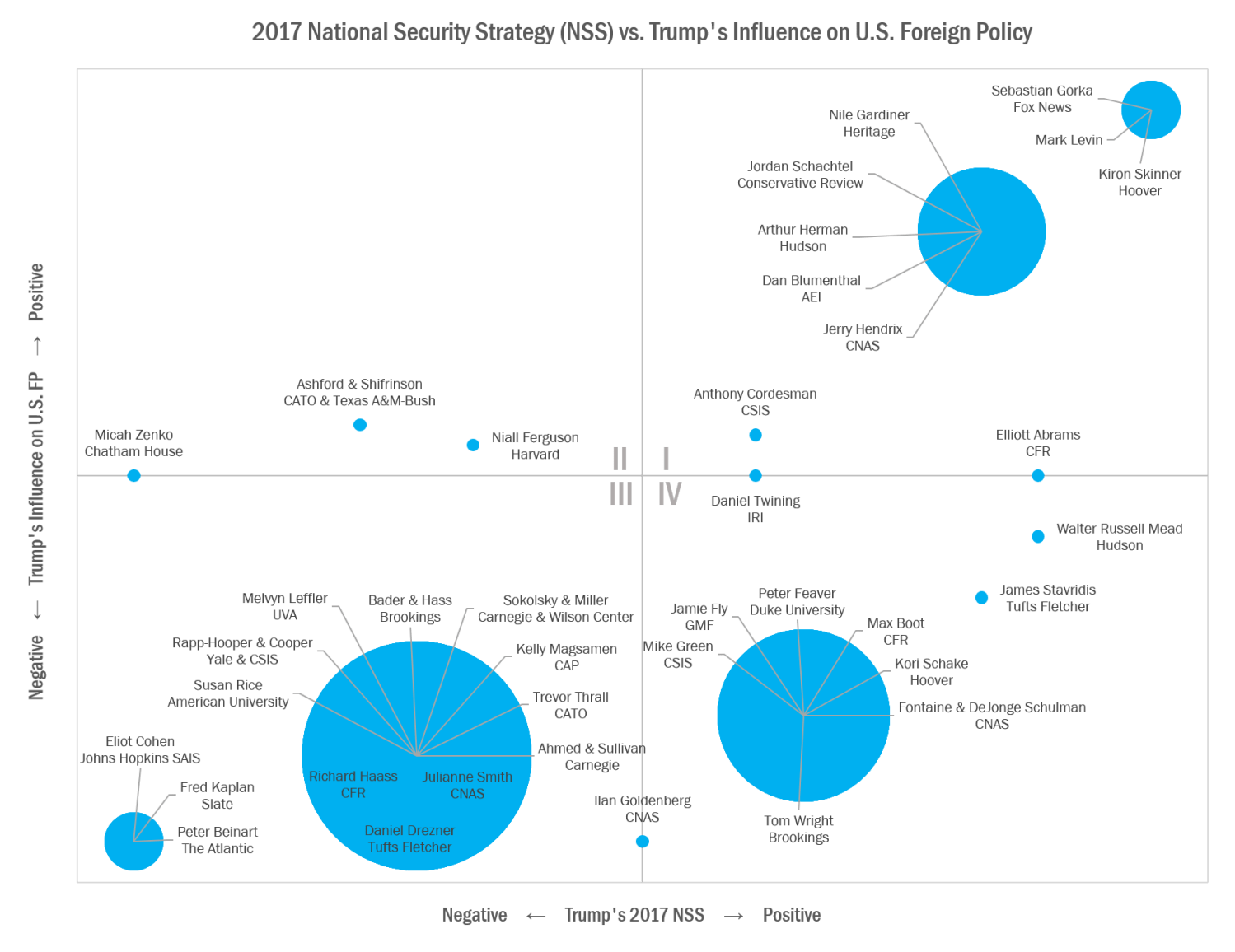
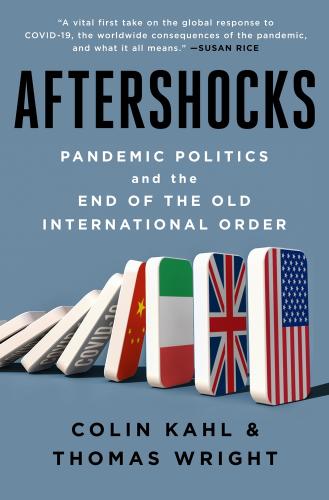
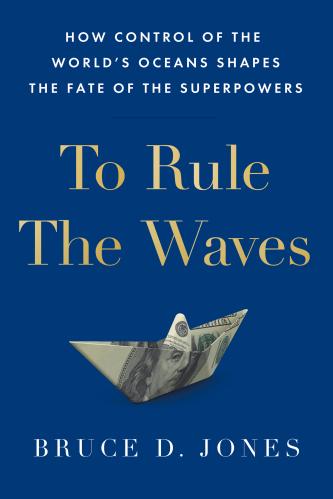
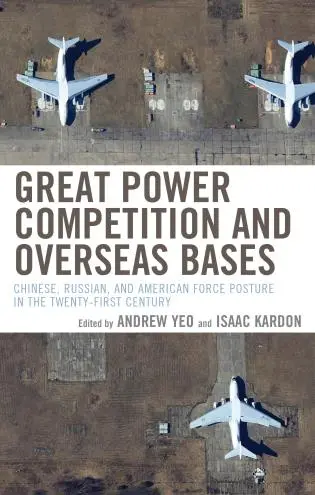


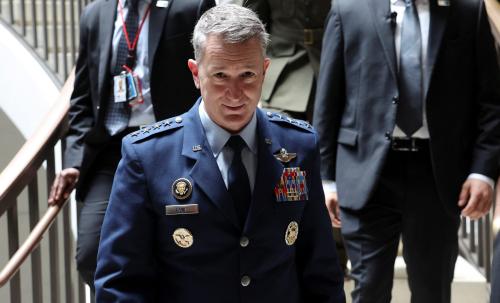


Commentary
Mapping reactions to Trump’s first National Security Strategy
January 10, 2018